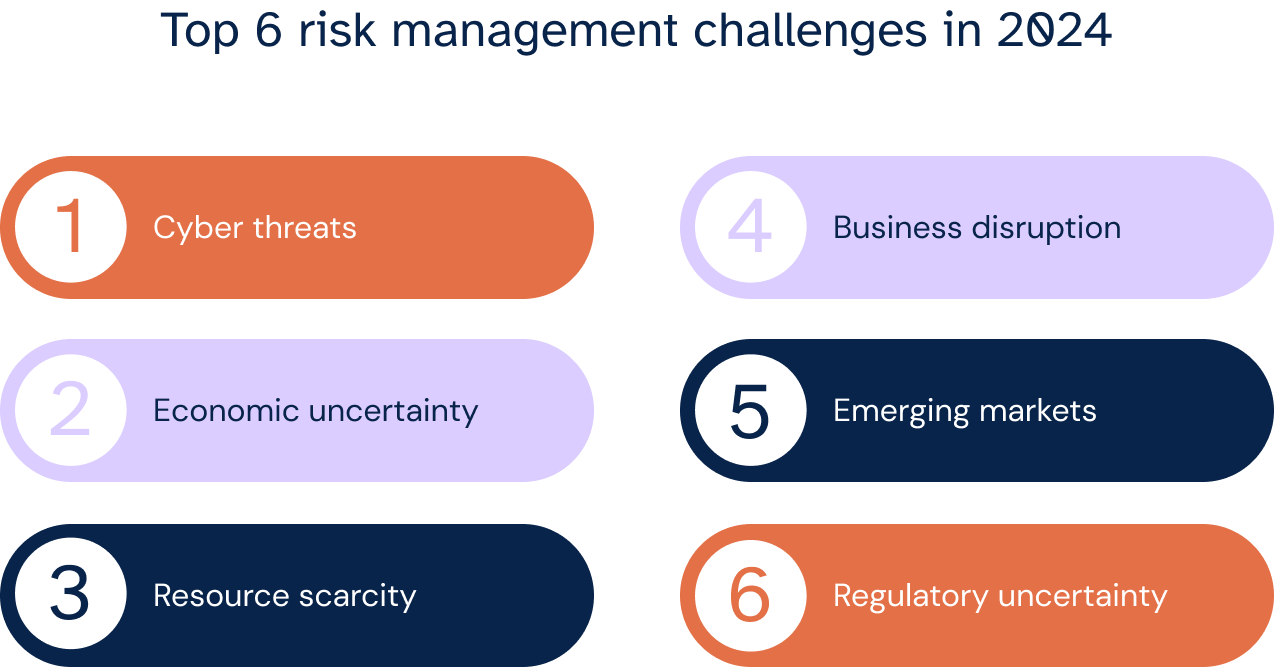Driven by emerging technological advancements and increasing uncertainties, the cyber risk landscape is advancing rapidly. That development paves the way for various risk management challenges that require strategic and dynamic responses.
Let's comprehensively analyze the top six risk management challenges global managers look at in 2024 and offer insights and actionable strategies to equip you with the knowledge and tools for managing risks effectively.

Cyber threats
With digital transformation happening across all industries, the first challenge organizations may face is the increasing sophistication and frequency of cyber threats, making effective and comprehensive cybersecurity practices more crucial than ever.
Addressing cyber threats is an ongoing process, not a one-time fix. By adapting to the modern threat landscape, organizations can significantly reduce their risk of cyberattacks and protect their critical assets.
Here are some key strategies organizations can implement:
- Proactive defense: Continuously assess vulnerabilities, deploy advanced security solutions like intrusion detection/prevention systems and endpoint protection, prioritize patching, and conduct regular penetration testing.
- Collaborative vigilance: Train employees on phishing awareness, incident response protocols, and secure password practices. Foster a culture where everyone is responsible for cybersecurity.
- Threat intelligence: Track emerging cyber threats, subscribe to intelligence feeds, and collaborate with industry partners to share knowledge and best practices.
When addressing developing cyber threats, it's important to consider your organization's specific size, industry, and regulatory requirements. Tailor your approach to ensure effectiveness and cost-efficiency.
Economic uncertainty
Driven by inflation, recessionary risks, energy price fluctuations, and geopolitical tensions, economic uncertainty is another challenge risk managers look at in 2024.
Economic uncertainty can pose significant challenges for organizations, impacting everything from financial planning to operational decisions. However, by adopting proactive risk management strategies, organizations can navigate these uncertainties and emerge stronger.
Organizations can address economic uncertainty through:
- Scenario planning: Develop multiple financial models based on different economic scenarios, from mild slowdown to recession. Identify potential risks and opportunities in each scenario to guide strategic decision-making.
- Cost optimization: Review expenses, identify areas for cost reduction without compromising quality and negotiate better terms with suppliers. Embrace lean processes and automation to improve efficiency.
- Financial flexibility: Diversify funding sources, maintain healthy cash reserves, and consider flexible financing options like lines of credit to prepare for potential economic downturns.
Organizations can also build resilience, improve their ability to adapt to changing market conditions, and emerge stronger from challenging times. Remember, the key is to be proactive, data-driven, and adaptable.
Resource scarcity
Another emerging challenge is resource scarcity, influenced by geopolitical conflicts and environmental concerns. That affects supply chain stability and encourages businesses to adopt sustainable and ethical sourcing practices.
However, organizations can effectively overcome resource scarcity, optimize resource utilization, and achieve their goals even in resource-constrained environments by adopting proactive risk management strategies.
Here are some key approaches:
- Resource prioritization: Clearly define organizational goals and prioritize activities based on the highest return on investment. Allocate resources efficiently to maximize their impact.
- Resource optimization: Implement innovative solutions like just-in-time production, cross-training, and resource sharing to maximize output with minimal input. Leverage technology to automate tasks and improve resource utilization.
- Alternative sources: Explore partnerships, consider outsourcing non-core functions, and diversify your resource base to reduce dependence on any single source and mitigate potential disruptions.
Business disruption
Fueled by technological advancements and changing consumer behaviors, business disruption becomes another challenge, requiring continuous adaptation and resilience. Organizations must anticipate and mitigate potential disruptions to maintain competitiveness and operational continuity. Organizations can adapt to business disruptions due to emerging technologies by following these strategies:
- Embracing innovation: Foster a culture of experimentation and innovation to identify new technologies and business models that can thrive in a changing landscape. Encourage employee ideas and pilot innovative projects.
- Agile teams: Build cross-functional teams with diverse skill sets and the ability to quickly adapt to and respond to market shifts and competitor actions. Empower them to make decisions and test new ideas.
- Continuous learning: Invest in employee training and upskilling programs to equip them with the skills and knowledge needed to adapt to new technologies and market trends. Stay ahead of the curve by learning from industry leaders and competitors.
When addressed effectively, organizations can become more resilient and adaptable in the face of technological disruption. They can turn potential threats into opportunities, develop innovative solutions, and stay ahead of the competition.
Emerging markets
Emerging markets also present both opportunities and risks. While they offer growth potential, they also come with unique regulatory, cultural, and economic challenges that require careful and informed decision-making.
Organizations can overcome the challenges of emerging markets and build sustainable success in new and dynamic environments by cultivating a culture of adaptability and risk awareness. Organizations can follow these strategies to manage the challenges of emerging markets:
- Market research and intelligence: Conduct in-depth research on your target market, including competitor analysis, cultural nuances, legal and regulatory frameworks, and potential economic and political instabilities.
- Localization: Tailor your product or service offerings, marketing messages, and distribution channels to cater to the specific preferences and needs of the local market. Show cultural sensitivity and respect.
- Strategic partnerships: Partner with local businesses, consultants, or cultural experts to gain insights, navigate the bureaucratic environment, and build trust with the community.
Regulatory uncertainty
Lastly, regulatory uncertainty, especially in data privacy, ESG compliance, and cross-border trade, adds another layer of complexity. Staying abreast of evolving regulations and ensuring compliance is paramount to avoid legal and financial repercussions. Organizations can address regulatory compliance challenges through the following:
- Proactive compliance: Stay informed about regulatory changes and invest in expertise to interpret complex regulations, assess compliance requirements, and advise on potential risks and mitigation strategies.
- Transparency and communication: Demonstrate a strong commitment to ethical business practices and compliance. Implement robust compliance programs and maintain open communication with regulatory bodies.
- Agility and adaptability: Design adaptable business processes that quickly adjust to changing regulations. Proactively identify potential compliance risks and have contingency plans to address them.
Effective risk management as a competitive advantage
As we have explored, risk managers today face complex threats like escalating cyber risks, economic volatility, resource scarcity, business disruption, emerging market uncertainties, and constantly changing regulations. Risk managers play an indispensable role in guiding their organizations through these challenges.
Risk managers enable intelligent, risk-aware decision-making by conducting robust risk assessments, monitoring leading indicators, liaising with business heads, and providing timely insights to leadership. As outlined in guidance from RIMS, OCEG, and other ERM bodies, they are essential for embedding a strong risk culture company-wide.
With their unique vantage point, risk managers also facilitate identifying potential opportunities alongside risks to support strategic growth.
Risk management will increasingly become an important component as the business environment grows more turbulent. Research from McKinsey indicates that high-performing risk management is becoming a competitive advantage. Organizations must equip risk managers with the right resources, executive access, and enterprise-wide mandate to unlock this value.
Equipped with cutting-edge technologies like AI-enabled risk modeling, advanced analytics, and GRC platforms, risk managers can provide even greater foresight to anticipate emerging risks before they become real threats. This intelligence and preparedness will allow companies to thrive. With robust risk management capabilities, organizations can build resilience to gain a sustained competitive advantage.
Written by Louis Strauss
Louis began his career in Berlin where he also founded Dobbel Berlin – Berlin’s curated search engine. Returning to Melbourne to join KPMG, Louis lead the development of software designed to distribute IP and create a platform for us by advisors and clients. While at KPMG, Louis also co-authored Chasing Digital: A Playbook for the New Economy. Louis is accomplished in stakeholder management, requirements gathering, product testing, refinement and project implementation. Louis also holds a Bachelor of Engineering and a Masters of Information Systems from the University of Melbourne.









